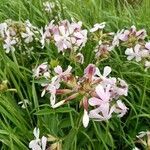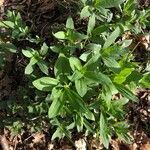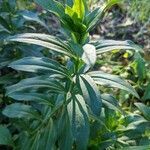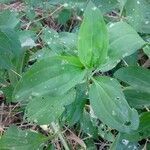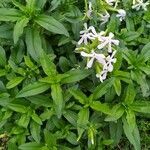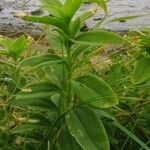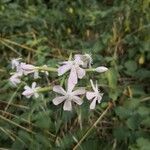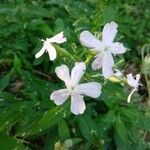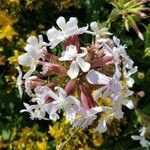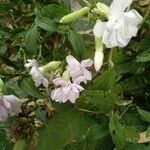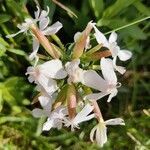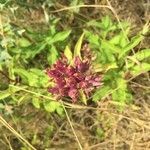Rhizomatous and stoloniferous perennial. Flowering stems stout, erect, glabrous or sparsely minutely papillate, 30-90 cm tall. Lvs ovate to narrowly elliptic, tapering to short petiole, becoming sessile above, prominently 3-veined, acute, glabrous or upper lvs scabrid on margins, 4-10 × 1.5-3 cm. Infl. a dense terminal cyme with lower branches bearing few-flowered dichasia; bracts linear-lanceolate, scabrid on margins, 1-2 cm long. Pedicels 3-5 mm long. Calyx cylindric or slightly inflated, (15)-18-23 mm long, glabrous or hairy; teeth broadly triangular, acute. Petals pink; claw > calyx; limb spreading, entire or emarginate, c. 1 cm long; coronal scales paired at base of limb, small, triangular. Capsule = calyx, oblong-ovoid, but often not formed; carpophore 2-3 mm long. Seeds blackish, c. 1.8 mm long.
Herb, perennial, usually glabrous. Stem erect, robust, 30–90 cm tall. Leaves sessile, elliptic to ovate-lanceolate, with basal leaves larger and cauline leaves reducing in size, acute, 25–100 mm long, 6–30 mm wide, conspicuously 3-veined. Inflorescence terminal, condensed, 6–25-flowered; bracts herbaceous. Pedicels 1–5 mm long. Calyx narrowly cylindrical-oblong, becoming ovoid in fruit, 17–20 mm long, 2-lipped, green or reddish, glabrous or pubescent; calyx lobes short, triangular-acute. Petal limb c. 10 mm long, white to pink, entire or subemarginate. Styles 2. Capsule ovoid-oblong, as long as calyx. Seeds discoid-reniform, c. 4 mm diam., black, bluntly tuberculate, with a lateral hilum.
Perennial herb with creeping rhizome. Stems erect, little branched, 0.5-2 m, glabrous or woolly hairy. Leaves oblong-elliptic or narrowly elliptic, acute or acuminate, up to 15 by 5 cm, lower ones petiolate, upper ones sessile, distinctly 3-nerved, subglabrous. Inflorescence terminal, short-peduncled, dense corymbs. Flowers fragrant. Calyx light green, cylindrical, in fruiting stage ± inflated, 20-25 mm, glabrous or pubescent, with 2 mm long acuminate teeth. Petals white to pink, claw narrow, mostly longer than calyx, lamina obovate with two, small coronal scales. Capsule oblong-ovoid, as long as calyx or slightly shorter. Seeds almost black, reniform to spherical.
Colonial by rhizomes, erect, 4–8 dm, mostly glabrous; lvs 7–10 × 2–4 cm, elliptic to elliptic-ovate or lance-elliptic, acute; infl congested and subcapitate to open and oblong-pyramidal, to 15 cm, the primary bracts leafy, the ultimate ones scarious; fls fragrant, often double; cal 1.5–2.5 cm, the lobes triangular-attenuate, the tube often becoming deeply bilobed; pet white or pinkish, the auricles none, the appendages conspicuous, the blade 8–15 mm, oblong to oblong-obovate; stamens exsert; 2n=28. Native of the Old World; formerly cult. and now established as a weed of roadsides and waste places or along railways throughout most of temperate N. Amer. Summer.
Plants perennial, colonial. Stems erect, simple or branched distally, 30-90 cm. Leaves: petiole often absent or winged, 0.1-1.5 cm; blade strongly 3(-5)-veined, elliptic to oblanceolate or ovate, 3-11(-15) × 1.5-4.5 cm. Cymes dense to open. Pedicels 1-5 mm. Flowers sometimes double; calyx green or reddish, often cleft, 15-25 mm, glabrous or rarely with scattered trichomes; petals pink to white, often drying to dull purple, blade 8-15 mm. Capsules ca. 15-20 mm. Seeds 1.6-2 mm wide. 2n = 28.
A small plant. It grows 30-60 cm high and spreads 50-100 cm wide. They form mounds of wiry stems. The leaves are grey-green and oval. They are pointed and 12 mm long. The flowers are pink, red or white and 25 mm wide. They are in heads of 5 or more flowers.
